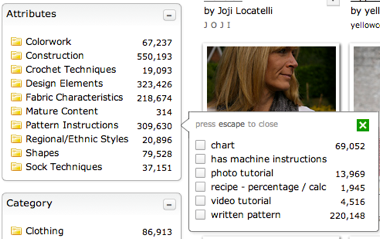I do love my Bergere de France patterns and this time
 |
| Dark blue colour is about right |
I'm making one from their
04/05 catalogue #753 .
I'm taking a break from sewing it up and posting about working with cables, working with dark colours and my new light.
The design has the first 18 in a 3:3 rib and the decreases are done 21 sts from the edge, flowing into cables up a raglan bodice.
Just the thing for my personal cableathon.
 |
| Cables on the machine |
 |
| Hard to see but there they are |
Even though the cables are over stretched on the machine, they resolve themselves when off the machine.
I know, I know, six impossible things before breakfast, lots of moving stitches for the raglan decreases, putting the KrisKrafter 20 needle decker/garter bar to good use, and a 7 sts cable.
For the back I took the cables off the machine and hand knitted them, however between doing the back, sleeves I went to a Susan Guagluimi Seminar on... fiddling around with the machine and tools.. right up my alley. However before I get to that story, I'll show you the light the electrician was using when installing LED lights in the building.
 |
| The LED light |
It's a caving light used by those outdoorsy types, and electricians and now machine knitters.
There is a down side - I get to wear it on my head... oh joy! Just as well it's something I can wear on my head when no one is around. And NO, there will not be a photo of smiling me wearing it, sooo sorry!
Anyways, here it is, a nice little LED light, the switch is on the top and it clicks up and down so my head stays still and the light moves.
 |
| How good the light is on the stitches |
 |
| Field of light when it's on my head |
So now with the LED light on my head, and Susan G's bridging cables, I thought I'd try it out on the fronts.
Did I mention that this is also called my Twice Knit Jumper? Yes, I've been knitting this for a month.. twice or more on most sections... but back to it.
OK, so what I did was - knit the first bridge, then set the carriage to hold/hold/part/part - so the only thing that would ever knit was needles in the UWP - I found this easier.
I put all the needles I needed to put on the other end in hold - not all of them, no, then about halfway-ish, all on hold, yes a small section on the other side of the bed had the exact number of needles in hold on the far end, and then some in working position, then hold up to the bridge.
Then knit the first couple of stitches, back up (nothing knits, everything is in hold or WP at this point.)
adjust the stitch dial plus 2 sizes in my case, put the four needles I need to do the cable cross nice and big, backup
Return to original stitch size, take off hold on the left side, and slowly knit across the next stitches, as soon I was past the lower needles already knitted, take of the left hand part, as soon as I was past the needles on hold, I slipped it back into hold,
When all the needles up to the last ones in hold are knitted, all the setting go back to hold/hold/part/part back up, plus 2 sizes up, 4 needles in UWP, knit them, back up, return to main st size, take off hold and knit the last few - now all the stitches have been knit, return all settings to knit, do the crosses, and this time I hand knit them off - plastic machines are more fragile than their metal cousins, however, it all knit off remarkably well and I learnt a lot about cables, giving my stitches some more yarn to do the crosses and I got quicker as I went along and I think I got almost to the end before I had to undo the last couple of rows.
Not quite what Susan said to do, but it worked for me! There's lots of things in her second book for me to try out over the next couple of projects, for my cableathon.
And here are the cables:
And my next cable pattern is a Vague aka Vogue pattern... with more bridging happening... wish me luck!
























































